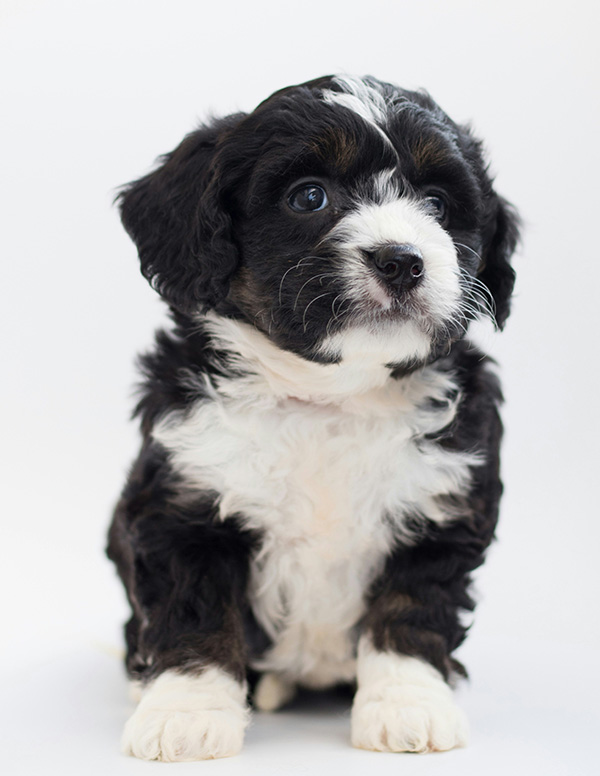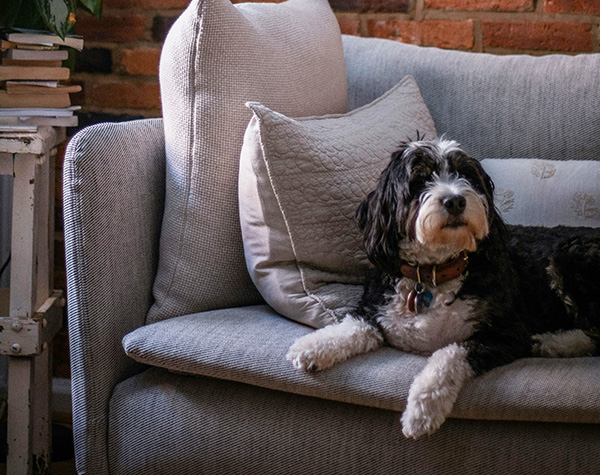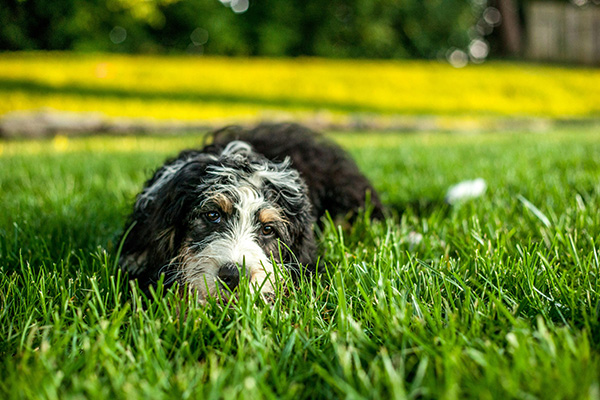Fluffy, friendly, and full of personality—the Bernedoodle is the ultimate companion dog! A mix between the loyal Bernese Mountain Dog and the intelligent Poodle, this designer mixed breed has captured the hearts of dog lovers everywhere. Renowned for their sharp minds, loving temperaments, and eye-catching looks, Bernedoodles inherit the finest qualities from their parent breeds. Their adaptable nature makes them wonderful companions for individuals, families, and seniors alike. Whether you're drawn to their adorable teddy bear looks, hypoallergenic coat, or playful nature, there's a lot to love about Bernedoodles.
In this in-depth guide, we will cover everything you need to know about Bernedoodles, including their history, distinctive traits, grooming requirements, temperament, and important health considerations.
Breed Characteristics
Temperament | Gentle, playful, affectionate |
Intelligence | high |
Affection/Friendliness | Very loving and loyal |
Trainability | high |
Mental Stimulation | High – obedience, agility, puzzle toys |
Exercise Needs | Moderate to high – walks, runs, play |
Apartment Living | Suitable |
Family Friendly | yes |
Pet Friendly | Yes, with socialization |
Drooling Level | low |
Energy Level | Moderate |
Loneliness Tolerance | low |
Adaptability | Moderate |
Tendency to bark | Moderate |
Origin
The Bernedoodle is a modern designer breed, first purposefully bred in 2003 by Sherry Rupke of SwissRidge Kennels in Canada. It was developed to blend the Poodle’s intelligence and low-shedding coat with the Bernese Mountain Dog’s affectionate and loyal temperament. While accidental crossings may have occurred earlier, Rupke is credited with refining and promoting the breed.
As a hybrid breed rather than a purebred, Bernedoodles are not officially recognized by major kennel clubs like the American Kennel Club (AKC) or the Kennel Club (UK). However, they are acknowledged by organizations that specialize in designer breeds, including the Designer Breed Registry (DBR), the International Designer Canine Registry (IDCR), and the Designer Dogs Kennel Club (DDKC). Despite their unofficial status in traditional clubs, Bernedoodles have gained immense popularity for their friendly nature, trainability, and suitability as family pets, service dogs, and therapy dogs.

Breed Overview
Height: 23–29"
Weight: 70–90 lbs
Height: 22–27"
Weight: 60–80 lbs
Breed Group
Designer
Life Span
12–18 years
Coat
Wavy or curly
Coat Length
Medium to long
Hypoallergenic
Yes (low-shedding)
Shedding Level
Low
Size
Bernedoodles are available in three primary sizes—Standard, Miniature, and Tiny—determined by the size of the Poodle parent. Their height and weight can vary greatly, allowing them to fit well with different owners and living environments.
The Standard Bernedoodle, a cross between a Bernese Mountain Dog and a Standard Poodle, usually weighs between 70 and 90 pounds and stands 23 to 29 inches tall at the shoulder. Due to their larger size, they thrive best in homes with ample space, preferably with a yard. The Mini Bernedoodle, a cross between a Bernese Mountain Dog and a Miniature Poodle, is smaller, ranging from 25-50 pounds and standing 18-22 inches tall. They come in a more manageable size while still maintaining the breed’s affectionate and playful personality. The Tiny (or Toy) Bernedoodle, bred from a Mini Bernedoodle and a Toy Poodle, is the smallest variation, weighing 10-24 pounds and standing 12-17 inches tall, making them ideal for apartment living.
Personality
The Bernedoodle is a highly intelligent, affectionate, delightful, and versatile breed, making it an excellent companion for many types of owners. With the Poodle’s intelligence, Bernedoodles are highly trainable and eager to learn. They thrive on positive reinforcement and enjoy engaging in mental challenges, such as puzzle toys and obedience training. Their energy levels vary based on size—Standard Bernedoodles tend to be moderately active, while Mini and Tiny Bernedoodles have higher energy levels. Daily walks and playtime are essential for keeping them happy and engaged and preventing boredom.
Bernedoodles are not known for excessive barking, but they will vocalize to alert their owners to anything unusual. They have a mild protective instinct, often being cautious around strangers, though they are not naturally aggressive or territorial. Bernedoodles are highly social dogs that thrive on human companionship. With proper socialization, they get along well with children, other pets, and even unfamiliar people. They are naturally alert and will notice environmental changes, but they are less intense than dedicated watchdog breeds.
Most Bernedoodles have a balanced confidence level, though some may inherit the Bernese Mountain Dog’s occasional shyness. Early socialization is key to shaping a well-balanced and adaptable temperament. While they are intelligent, they are not highly independent dogs and prefer to be with their family members. Bernedoodles form strong bonds with their owners and can be prone to separation anxiety, potentially leading to destructive behavior if left alone too frequently. Fortunately, aggression is not a common trait in this breed; they are typically gentle and friendly, only showing defensive behaviors if they feel threatened or lack proper socialization.
Temperament

The Bernedoodle is a loving, playful, and easygoing breed, making it a fantastic companion for families, singles, and seniors. These dogs thrive on human connection and enjoy being involved in family activities. Their friendly and social personality also makes them a great fit for homes with children and other pets.
When it comes to other dogs, Bernedoodles are typically very sociable. They enjoy playing with canine companions and do well in multi-dog households. Early socialization is essential for helping Bernedoodles develop good manners around other dogs and preventing potential dominance issues. Their interaction with cats depends on early exposure. While some Bernedoodles may instinctively chase smaller animals, most can learn to coexist peacefully with feline friends, especially if introduced properly.
Bernedoodles are also great with children, making them an ideal family dog. They are patient, gentle, and playful, though supervision is always recommended with younger kids to prevent accidental rough play. As for strangers, Bernedoodles are generally friendly but may be slightly cautious at first. However, once they recognize there is no threat, they quickly become friendly with new people. With the proper socialization, they become outgoing and affectionate, making them an excellent choice for sociable households.
Diet/ Nutritional needs
A Bernedoodle’s diet should be well-balanced, providing the necessary nutrients for their size, age, and activity level. High-quality dry kibble, raw food, or a fresh diet balanced with protein, healthy fats, and carbohydrates is ideal. Protein sources like chicken, beef, fish, or lamb support muscle health, while omega fatty acids promote a healthy coat. Since Bernedoodles are susceptible to bloat, offering smaller, more frequent meals can help reduce the risk of digestive problems. They also need glucosamine-rich foods to support joint health, especially in larger Bernedoodles. Always provide fresh water and consult a veterinarian for guidance on portion sizes and dietary adjustments.
Activity/ Exercise
Bernedoodles are active dogs that need daily exercise, including walks, playtime, and mental enrichment, to stay healthy and engaged. Mini and Tiny Bernedoodles tend to have higher energy levels and may require more frequent activity throughout the day.
They thrive on a combination of physical and mental activities, including fetch, agility training, hiking, and obedience games. Since they are intelligent, they also thrive on puzzle toys and training exercises. While they love being active, Bernedoodles are not hyperactive dogs and can relax indoors after proper exercise.
A lack of exercise can result in boredom, anxiety, and destructive behavior, making regular physical and mental stimulation crucial. Swimming is another excellent activity for Bernedoodles, as many inherit the Poodle’s love for water. Since they are highly social, they also benefit from dog park visits or playdates with other dogs. Bernedoodles can adapt to both apartments and homes with yards, provided they get enough exercise and mental stimulation.
Appearance/ Colors

Bernedoodles have a charming, teddy bear-like appearance, with a fluffy, wavy, or curly coat that varies depending on their genetics. Their coat texture is often soft and low-shedding, thanks to their Poodle lineage, making them an excellent option for allergy-sensitive owners.
Bernedoodles come in a variety of colors, with the most desirable being the tri-color pattern, which mirrors the black, white, and rust markings of the Bernese Mountain Dog. However, they also appear in bi-color (black and white, brown and white), merle, sable, phantom, or solid colors like black, cream, or apricot. Coat patterns can change slightly as they grow, with some fading over time.
Their body structure is sturdy yet well-proportioned, and their size varies depending on whether they are Standard, Miniature, or Tiny Bernedoodles. They typically have expressive eyes, a black button nose, and floppy ears, giving them a friendly and affectionate look. Their tail is often fluffy and slightly curled or wavy. When possible, it's best to meet the puppy's parents to get a better idea.
Grooming needs
Bernedoodles require moderate to high grooming, depending on their coat type. Their fur can be wavy, curly, or straighter, with curlier coats (resembling Poodle coats) requiring more maintenance. Routine grooming is crucial to prevent matting and tangles, particularly around the ears, chest, and legs. To keep their coat healthy, Bernedoodles should be brushed at least 3-4 times a week, though daily brushing is ideal for those with curlier fur. Using a slicker brush and metal comb helps remove loose hair and prevent tangles.
Professional grooming every 6–8 weeks is recommended to keep their coat trimmed and manageable. Many owners prefer a puppy cut, which maintains a shorter coat and minimizes shedding. Bathing every 4–6 weeks with a gentle, dog-friendly shampoo helps prevent skin dryness. Overbathing can strip their natural oils, leading to irritation.
Other grooming needs include regular ear cleaning to prevent infections, teeth brushing at least 2-3 times a week for oral health, and nail trimming every 3-4 weeks to avoid overgrowth. With proper grooming, Bernedoodles stay clean, comfortable, and healthy while maintaining their signature fluffy, adorable appearance.
Adaptability
Bernedoodles are versatile dogs that can adjust well to different living environments. Whether in an apartment, suburban home, or rural setting, they thrive when given adequate exercise and mental stimulation. Smaller Bernedoodles, such as Mini and Tiny varieties, adapt well to apartment living, while Standard Bernedoodles benefit from more space to move around.
Their thick coat affects how well they adapt to different climates. With their Bernese Mountain Dog lineage, they tolerate cold weather well but may have difficulty in hot climates. To keep them comfortable in warm conditions, owners should ensure access to shade, offer plenty of water, and limit outdoor activity during peak heat.
Bernedoodles are highly social and thrive in family-oriented environments where they receive plenty of attention and companionship. They are not very independent and may develop separation anxiety if left alone for extended periods. While they adjust well to new environments and routines, they thrive when given consistency and positive reinforcement.
Trainability
Bernedoodles are highly trainable due to their intelligence, willingness to please, and deep attachment to their owners. They inherit the high intelligence of the Poodle, making them quick learners, while the loyal and affectionate nature of the Bernese Mountain Dog gives them a strong desire to work with their family.
Bernedoodles thrive with positive reinforcement techniques, including treats, praise, and play. They are generally easy to train, but consistency and patience are key. Their intelligence allows them to learn commands quickly, but they can sometimes be stubborn, especially if they inherit the Bernese Mountain Dog’s independent nature. Starting training early and using short, engaging sessions helps keep them focused. Bernedoodles can be sensitive to harsh corrections, so a gentle, encouraging approach works best. Some may also struggle with separation anxiety, making crate training beneficial to help them feel secure.
Early socialization is essential for raising a well-behaved and confident Bernedoodle. Introducing them to different people, animals, environments, and experiences from a young age helps prevent fearfulness or shyness. Basic obedience training, including commands like sit, stay, and recall, should start early, as Bernedoodles can be naturally energetic and excitable.
Life expectancy

Bernedoodles typically live between 12 and 18 years, with lifespan influenced by factors such as size, genetics, and overall health. Like many dog breeds, smaller Bernedoodles generally have longer lifespans than their larger counterparts. Standard Bernedoodles, which come from a Standard Poodle parent, typically live around 12-15 years, while Mini Bernedoodles (from a Miniature Poodle) have a lifespan of 13-17 years. The smallest variety, Tiny Bernedoodles, often live the longest, averaging 14-18 years.
Cost
The cost of a Bernedoodle varies widely, typically ranging from $2,000 to $5,000, depending on factors like reputable breeder, size, coat color, location, and generation (F1, F1b, etc.). Some rare or high-demand puppies, especially those with tri-color coats resembling the Bernese Mountain Dog, can be even more expensive.
Size plays a role in pricing, with Mini and Tiny Bernedoodles often costing more than Standard Bernedoodles due to higher demand. Coat color also affects price, as tri-color Bernedoodles are the most sought-after, while solid or bi-color puppies tend to be more affordable. Age is another factor that can impact the cost. A Bernedoodle puppy can be much more costly than an adult Bernedoodle.
Breeder reputation is another major factor—ethical breeders who focus on health testing, socialization, and responsible breeding charge higher prices but ensure a healthier, well-adjusted puppy. Additionally, F1b and multigenerational Bernedoodles, which have more predictable coat types and hypoallergenic traits, often come at a premium.
Potential Health Issues
Like most mixed-breed dogs, Bernedoodles are generally healthier dogs than purebred dogs. They are at a lower risk of hereditary diseases and health concerns found in their Poodle and Bernese Mountain Dog parents. However, they may still be susceptible to certain health conditions.
Elbow and Hip Dysplasia
Hip and elbow dysplasia are common in Standard Bernedoodles, as larger dogs are more prone to joint issues. These conditions arise when the hip or elbow joints develop improperly, causing pain, arthritis, and mobility issues. Common signs include limping, stiffness, and difficulty standing up or climbing stairs. While genetics play a role in dysplasia, managing weight, incorporating joint supplements such as glucosamine and chondroitin, and ensuring regular, moderate exercise can help alleviate symptoms. Responsible breeding practices can lower the risk.
Progressive Retinal Atrophy (PRA)
PRA is an inherited eye condition that progressively deteriorates the retina, ultimately resulting in blindness. It is more common in Poodles, meaning Bernedoodles can inherit it. Early symptoms include trouble seeing in dim light, bumping into objects, and increased caution at night. While there is no cure, regular eye exams and genetic testing can aid in early detection. Since blind dogs can still live happy lives, training them with verbal cues and keeping their environment consistent can help them adjust.
Bloat (Gastric Dilatation-Volvulus - GDV)
Bloat is a severe, life-threatening condition in which the stomach fills with gas, fluid, or food and then twists, restricting blood flow. This can happen suddenly and requires immediate emergency surgery. Large, deep-chested dogs like Standard Bernedoodles are more prone to bloat. Signs of bloat include a swollen abdomen, excessive drooling, restlessness, and unsuccessful attempts to vomit. To prevent bloat, owners should feed smaller, frequent meals, use slow-feed bowls, and avoid intense exercise right before or after eating.
Skin Allergies
Bernedoodles can develop food, environmental, or contact allergies, leading to itching, redness, hot spots, hair loss, or ear infections. Allergens can include pollen, dust mites, certain proteins (like chicken or beef), or grooming products. If a Bernedoodle constantly scratches or licks, a vet may recommend an allergy test, a hypoallergenic diet, or medicated shampoos. Proper grooming, flea prevention, and a balanced diet rich in omega fatty acids can help maintain healthy skin and coat.
Heart Disease
Bernedoodles can be prone to heart conditions inherited from their parent breeds, such as mitral valve disease and dilated cardiomyopathy. These conditions can cause lethargy, coughing, difficulty breathing, or fainting. Regular vet checkups, listening for heart murmurs, and a heart-healthy diet (low in sodium, with added taurine and antioxidants) can help maintain heart health. If diagnosed, symptoms can be managed with medications and lifestyle adjustments.
Epilepsy
Some Bernedoodles may develop epilepsy, a neurological disorder that causes seizures. Seizures can vary in intensity, from mild symptoms like twitching and staring to severe episodes involving loss of consciousness and convulsions. The exact cause is often unknown, though genetics may play a role. If a Bernedoodle has seizures, a veterinarian may recommend anti-seizure medication to help control the condition. Maintaining a low-stress environment and monitoring seizure triggers (such as flashing lights or certain foods) can also be beneficial.
Ear Infections
Bernedoodles have floppy ears, which make them prone to ear infections due to trapped moisture, dirt, or wax buildup. Common symptoms include head shaking, scratching, redness, foul odor, and discharge. To prevent infections, clean their ears weekly using a vet-approved cleaner and always dry them after baths or swimming. If an infection occurs, a vet may prescribe antibiotic drops or antifungal medication.
